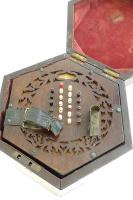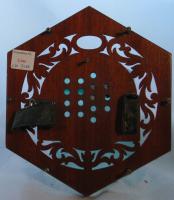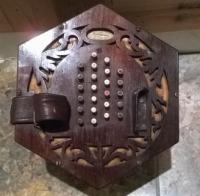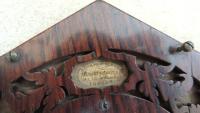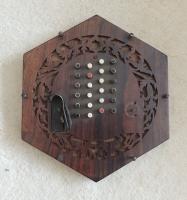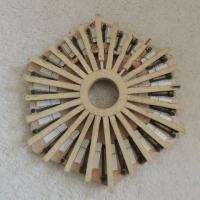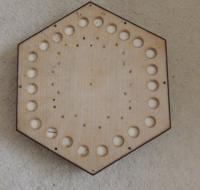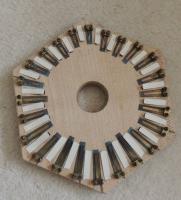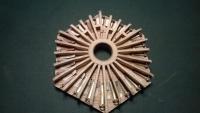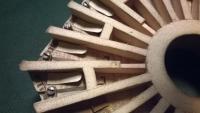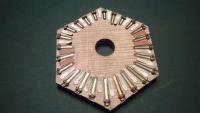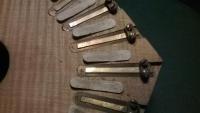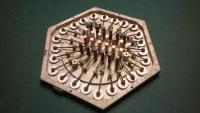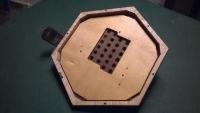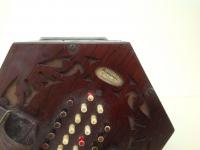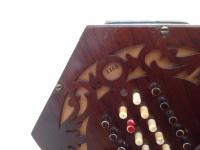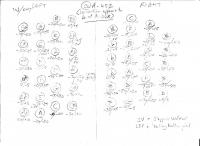-
Posts
81 -
Joined
-
Last visited
Everything posted by banjojohn
-
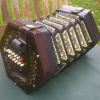
Keith Prowse 48 Button English S/n 1155
banjojohn replied to banjojohn's topic in Concertina History
Hi Bazza, what auction is that? Ok, Bazza, I've just sussed the auction and see what you mean, I reckon that your S/n 21 is hot for being a George Case! -

Keith Prowse 48 Button English S/n 1155
banjojohn replied to banjojohn's topic in Concertina History
Malcolm, thanks for your explanation of 'IMHO', but what I was really wanting to know was exactly what these "pretty obvious" differences are between 1155 and Bazza's 21... Because they are certainly not obvious to me! I do admit that I am a novice in the world of concertinas, that was a big reason for me to start posting on this forum... So please now spill the beans! P.S Bazza didn't send me any photo of the action of 21, but I'm mystified about the small 'dots' that are apparent in his photo of the underside of it... Got any idea what these are? -

Keith Prowse 48 Button English S/n 1155
banjojohn replied to banjojohn's topic in Concertina History
It has occurred to me that I have already read in Wes Williams's article at http://www.concertinas.org.uk/others.htm#KeithProwse that "It is interesting to note that 'Mr. W Prowse', who ran the company from 1846 to 1865, purchased 16 concertinas from Wheatstone during 1851 (but none in 1852)." As the Keith, Prowse & Co instrument S/n 1155 appears to have 'Wheatstone pattern' fretwork, is it not possible that it is indeed one of those 16 concertinas purchased from Wheatstone in the year 1851 and re-labelled as a K,P & Co ? In looking up Wheatstone' ledgers at: http://www.horniman.info/WNCMARC/C104A/PAGES/C1P0590S.HTM, there are listed numbers 1141 to 1160 for the year 1846 and though number 1155 is included, there is no entry against that number... But there are also other S/ns with no entries recorded... is it not possible that these unrecorded (unsold?) concertinas were the ones which were later bought by Keith, Prowse & Co in 1851? -

Keith Prowse 48 Button English S/n 1155
banjojohn replied to banjojohn's topic in Concertina History
Compare the fretwork design on Keith, Prowse #1155 with this Wheatstone, #3188, (a very cheap 32-Key single-action instrument sold on 17th January 1851), which is an early example of one of the Wheatstone concertinas that I'm talking about (though I wouldn't agree with most of the description of it! ) Ok so here is the comparison, the Wheatstone 3188 on the left and the Keith, Prowse & Co on the right I must say that the fret work looks very similar, but does this prove that 1155 was made by Wheatstone? -

Keith Prowse 48 Button English S/n 1155
banjojohn replied to banjojohn's topic in Concertina History
Quote from Malcolm Clapp: IMHO, there are more differences than similarities between these two instruments; I would be surprised if they came originally from the same maker. Malcolm, excuse my igorance, but could you please explain these differences? And what does IMHO stand for?? -

Keith Prowse 48 Button English S/n 1155
banjojohn replied to banjojohn's topic in Concertina History
Bazza has very kindly sent me some photos of his very early Keith, Prowse & Co, and has given his permission to post them here: Apart from the more ornate fretwork, the obvious difference between this and 1155, is the square ended reed shoes -

Keith Prowse 48 Button English S/n 1155
banjojohn replied to banjojohn's topic in Concertina History
Last night I opened up the left hand end of 1155 and photographed the internals.. Of obvious note is the shape and fit of the spruce baffle plate, slightly less obvious are the two sections of felt gasket which have been apparently intentionally left short up at the top end, see enlargement for this... -

Keith Prowse 48 Button English S/n 1155
banjojohn replied to banjojohn's topic in Concertina History
Stephen, thank you for your insights here! So to conclude; you believe that these early concertinas labeled Keith, Prowse & Co were manufactured by Bankham, Card, Potter, and Parrish, who were I presume either directly employed by K, P & Co, or were independent craftsmen who were contracted to make and assemble the parts. By independent, I mean not exclusively contracted to any particular maker name, eg Wheatstone? So these instruments could not be attributed to Wheatstone.... Ie; the serial number 1155, is not a Wheatsone S/n? -

Keith Prowse 48 Button English S/n 1155
banjojohn replied to banjojohn's topic in Concertina History
Hi Bazza, Wow! . . . No. 21 sounds like it could have been made in the first week!....would you please be able to post some photographs on this thread? -

Keith Prowse 48 Button English S/n 1155
banjojohn replied to banjojohn's topic in Concertina History
Have just copied this info from the 'Concertina History Resource' web site: http://www.concertinas.org.uk/others.htm#KeithProwse, the Horiman referred to, is a museum which has a large collection of old musical instruments, including concertinas. I am interested to note that they have S/n 1156 the next number up from mine! From my reading/understanding of the information below, I would conclude that concertinas were being made by Keith, Prowse and Vickers until 1888. Note the comma between the names Keith and the name Prowse, this comma is also present on the original labels... (I had wrongly assumed that Keith was a First Name). However is seems that these are two individuals, a Mr Keith and a Mr Prowse, who together with a Mr Vickers were making concertinas...... William Dove - 20 Poland Street, Oxford Street. Dove, another Wheatstone worker, started manufacturing around 1850. He did not remain in business for long according to Jones, and the company was taken over by Keith, Prowse & Co.. Directory listings for Dove disappear after 1852. The two Horniman Dove instruments are Nos.217 and 234, and the lowest Prowse No 1156 (Keith, Prowse and Vicker). Keith,Prowse & Co. As noted above the lowest 'Prowse' in the Horniman is No 1156, and the highest No.4842. It is interesting to note that 'Mr. W Prowse',who ran the company from 1846 to 1865, purchased 16 concertinas from Wheatstone during 1851 (but none in 1852). The Keith, Prowse and Vicker instrument above probably dates to before 1865, and the Keith, Prowse and Co instruments (Nos. 1360 and 4842) after that. By 1888 they were selling rebadged Lachenals from 48 Cheapside. -
I have recently become the custodian of this instrument, the seller believes it to be a Wheatstone, only labelled and sold by Prowse... At this web page http://www.concertinamuseum.com/CM00254.htm there is a similar instrument with an slightly earlier serial number, with the detail that the maker is Keith, Prowse & Co. Does anyone have any knowledge as to the activities of Keith, Prowse & Co, did they actually make any instruments? The label at least says 'Manufacturers'. Was posing as being a maker, when you were really a distributer/retailer a known practice of these times? If Keith and Prowse were not makers, then who might have made this concertina (S/n 1155) and how old is it likely to be? (Edited on 25/11/15, to insert the comma between 'Keith' and 'Prowse', to change 'he' to 'they' etc, as I had mistakenly read the label as being Keith Prowse & Co (assuming Keith to be a first name).
-

Tuning Of Old Lachenal English Concertina
banjojohn replied to banjojohn's topic in Instrument Construction & Repair
Thanks, for this Theo... As a matter of fact you have supplied me with several replacement reeds for my other Lachenal 48 button box, I did actually try to phone you a couple of times recently, regarding yet another replacement, but was only able to leave messages.. When I got no reply I assumed that you might not be in this business any longer, so I ended up making the reed myself, see my other posting on this forum... Are you still doing reeds? -

Tuning Of Old Lachenal English Concertina
banjojohn replied to banjojohn's topic in Instrument Construction & Repair
Geoff, Thanks for your reply, yes I shall definitely look into reed cleaning next... I have David Elliot's repair manual to guide me in this process, but does anyone out there have any other tips or good tried and tested methods of cleaning, would for instance methylated spirits and a soft artists brush be an OK? -

Tuning Of Old Lachenal English Concertina
banjojohn replied to banjojohn's topic in Instrument Construction & Repair
Ok, last night I had a fiddle about with the calibration setting on my Korg, I had a hunch that the A4 on this instrument was in pretty good shape as it sounded very good on both reeds and was pitched equally. Assuming that the instrument was in quarter comma mean tone, I decided to adjust tuner calibration until this A4 was measuring 10 cents flat (from tuning chart). This resulted in a calibration setting of A = 450Hz. This is obviously close to Old Philharmonic pitch of A = 452 (S/N 32159 dates from about 1890 I believe). Can I assume that the flatness in down to age and or the fact that the reed tongues have not been cleaned yet and therefore could have deposits on them which are slowing them down slightly? Having established the tuner setting, I then proceeded to measure every reed and recorded the results. What I did next was to average the values recorded on each pair and compile these figures onto my 1/4 comma mean tone chart, I then averaged these deviations across all octaves for each note. The result strongly suggests that 32159 is in 1/4 CMT, with average deviations being within +/- 5 cents for all notes! Please see attached chart: Mean Tone Tuning Result 32159.pdf -

Tuning Of Old Lachenal English Concertina
banjojohn replied to banjojohn's topic in Instrument Construction & Repair
I will do another full tuning measure on 32159, following the method I have outlined in the notes on 'mean tone tuning chart rev 1.pdf'. I will report the results back to this posting thread in due course.... Really interested in this now and eager to find out how close to this temperament 32159 really is after all these years... -

Tuning Of Old Lachenal English Concertina
banjojohn replied to banjojohn's topic in Instrument Construction & Repair
The cent values I quote in my chart are form this chart, found on https://en.wikipedia.org/wiki/Quarter-comma_meantone ... I don't believe there are mistakes in rev 1 of my chart (if all my values are adjusted by +10, they are all within 1 cent of your values) As I said before, this is all relative and depends upon which note the tuner decides to use as a reference point, I started with C because that had been given the cent value of zero in the chart on the above site (tried to paste it in here, but it looses it's table format) -

Tuning Of Old Lachenal English Concertina
banjojohn replied to banjojohn's topic in Instrument Construction & Repair
Thanks, for this Geoff, I have already corrected that mistake on my spread sheet (subtracted the two values the wrong way round, so the + and - signs were interchanged) I believe it makes no difference which note is taken as a 'starting point', as the pitch increments in cent valus are always relative to that first note? -

Tuning Of Old Lachenal English Concertina
banjojohn replied to banjojohn's topic in Instrument Construction & Repair
Mean Tone Tuning Chart rev01.pdf Hi Geoff, I have just come up with this chart (prior to reading your post), does this make sense and agree with the values you have been using for tuning ECs? -

Tuning Of Old Lachenal English Concertina
banjojohn replied to banjojohn's topic in Instrument Construction & Repair
Thanks for this Dave, so what you are saying is that using this Kirnberger III setting on my tuner would not be the way to check the tuning on this instrument, which Greg (posted on this thread earlier) feels may have originally been tuned to 1/4 comma mean tone? Can anyone advise on a suitable tuning method? -

Tuning Of Old Lachenal English Concertina
banjojohn replied to banjojohn's topic in Instrument Construction & Repair
Also just noted that my tuner has a Kirnberger III setting, I've just researched this and copied the text below from Wikipedia... Is this 1/4 comma mean tone? or is 1/4 comma wolves something else??? Kirnberger III[edit] After some disappointment with his sour, narrow fifths, Kirnberger experimented further and developed another possibility, Kirnberger III. (These names were not used at the time and are of modern invention.) This temperament splits the 1/2-comma wolves between four fifths instead of two, allowing for four 1/4-comma wolves to take their place. 1/4-comma wolves are used extensively in meantone and are much easier to tune and to listen to. This also eliminates two of the three pure thirds found in Kirnberger II. Therefore, only one third remains pure (between C and E), and there are fewer Pythagorean thirds. A greater middle ground is thus reached in this improvement, and each key is closer to being equal to the next. The drawback is an aesthetic one: fewer chords have pure thirds and fifths. But every temperament system has a give-and-take compromise; each has to find a way of dealing with the comma. -

Tuning Of Old Lachenal English Concertina
banjojohn replied to banjojohn's topic in Instrument Construction & Repair
Thanks Cboody, the dulcimer demo is very clearly explained... Just found a tuning chart for quarter comma mean tone at http://xenharmonic.wikispaces.com/Quarter-comma+meantone I guess I just pick out the notes which are relevant to my instrument, then work out the deviation from equal temepered notes and use my Korg tuner to tune to these said deviations. Starting to feel like I'm almost there now... Going to design and make sounding/tuning rig, thinking of adapting the plastic bellows of one of those cheap and cheerful air bed foot pumps to supply the suction... Just been looking closely at my Korg OT-120 tuner... It has a temperament mode, which it says can be used if you are tuning a transposing instrument (what's that?) or tuning to a classical scale. It has a variety of options, including Mean Tone Eb and Mean Tone D#, can anyone tell me if either of these will do for 1/4 comma mean tone? -

Tuning Of Old Lachenal English Concertina
banjojohn replied to banjojohn's topic in Instrument Construction & Repair
Just been reading up all about mean tone etc, all seems pretty complicated, and very mathematical! I must admit, I had absolutely no idea about any of this stuff... Up until now I was living in a safe little world where there were 8 steps in an octave with a few sharps and flats in between and all could be simply checked with a tuning meter! Now that world seems to be falling apart! Is an octave 1200 cents? -

Tuning Of Old Lachenal English Concertina
banjojohn replied to banjojohn's topic in Instrument Construction & Repair
Thanks very much to Jim and Greg for your repies on this.... It seems that the more one delves into these old instruments, the more fascinating it all becomes (and the more complicated!)... What I nearly wrote in my original post, was that I was more than a bit puzzled by the fact that according to the tuning meter, the instrument's tuning appears to be 'all over the place', but at the same time it actually doesn't sound too bad when a tune is played on it. This apparent contradiction would obviously start to make sense if the some of the notes are intended to be at slightly different pitches, pressumably as means of enhancing the perception of the sound as note changes are made in the progress of the melody....? I must admit that I am finding this quite difficult to get my head around at the moment. It seems that what I must do now is some further research into '1/4 comma mean tone tuning' to try to understand this better. Must also devise a strategy/method which will allow me to tune this instrument to it's original tuning system. I have now decided against tuning it to modern concert pitch, as I would like to keep it as antique as possible (it still has it's original bellows) Is there anyone out there who can tell me how sharp/flat each note should be and at what frequency calibration setting my tuner should be set? One thing I did try last night was to try different frequency settings on some of the notes which were reading 30 cents flat @ A=452, the best fit seemed to be around A=448 or 449, so this instrument may be in the category that Greg mentioned in the previous post (concertinas tuned 12 cents high)? -
I started to discuss this particular instrument by posting on the topic 'New Reeds or Re-Tune'. But since re re-tuning of an English is really a different topic to re tuning for a key change, I thought I'd better start a new topic. I thought this old concertina (S/N 32159) was in Old Philharmonic pitch (A=452), however I measured it last night and it seems that whilst a few of the sharps/flats do seem to be at this pitch, most of the most of the notes seem to be well flat by 20 to 40 cents... Is this to be expected on an old instrument which has not been never been re tuned? I tried different pitches on the tuner and discovered that a note which is 30 cents flat at A=452, is only 10 cents sharp at A=440. In other words the concertina seems to be actually closer to modern concert pitch, than it is to the old pitch standard... I am still unsure as to how to re tune it, do I take it up to A=452, or down to A=440??? Please can anyone advise? Tuning chart attached
-
Dear Dana Just been reading your post here above and wondered if you had any advice re my tuning dilemma: I have an Lachenal English Concertina in the old philharmonic pitch standard (A = 452 Hz, as against modern concert pitch of A=440Hz), I pressume the instrument dates to pre 1896... I have been toying with idea of retuning it down to modern concert, but so far have never got around to starting. Mainly because I feel daunted by the prospect of retuning 96 reeds! I have only recently got into doing my own maintenance and repairs and don't have a lot of spare time. I do have another Lachenal which is in concert pitch, so really the only reasons for re tuning this one would be to (possibly) increase the sale value? I bought this one on Ebay from a seller who obviously knew nothing about concertinas and I also had no idea at that time that old instruments were tuned to different pitch standards... I probably would not have bought it if I had known that I could not use it in pub sessions played at concert pitch. However, as I only paid £350 for it I do not really feel ripped off! The question is should I retune or not???


